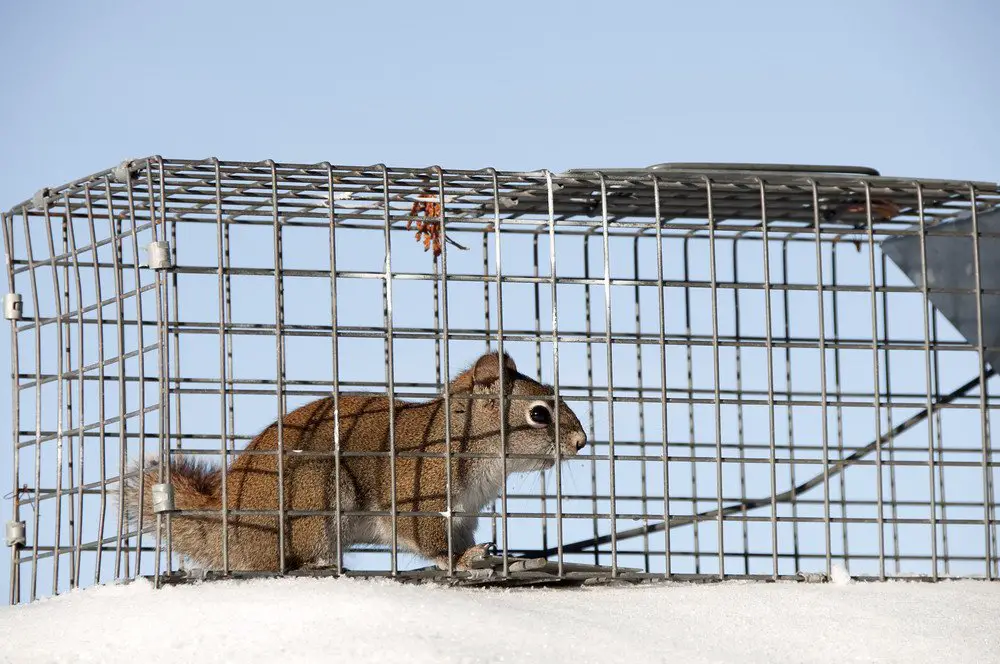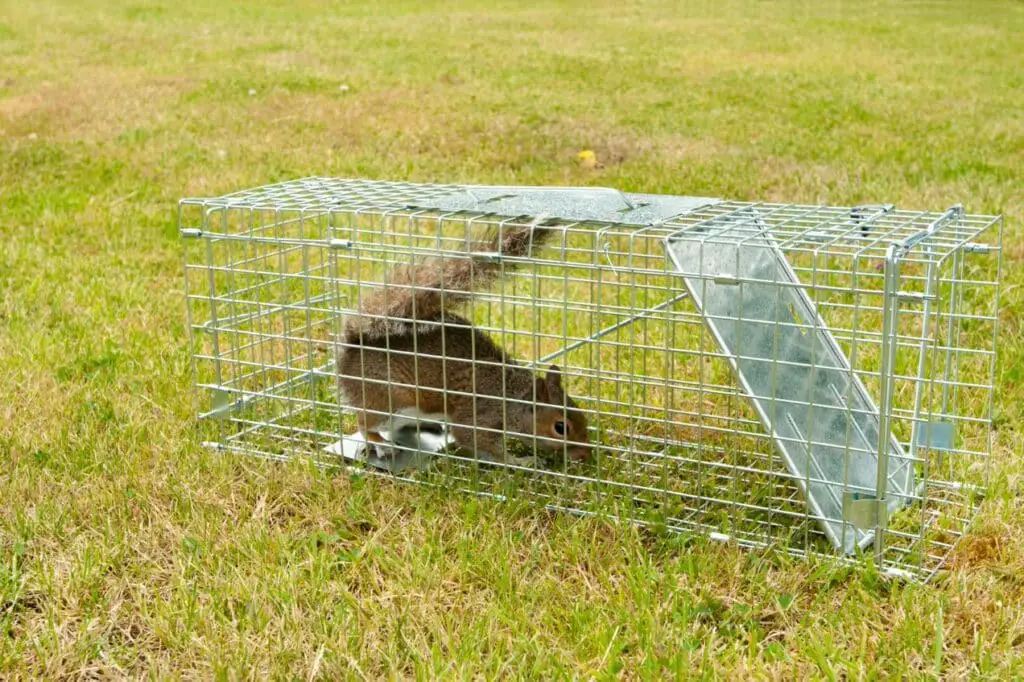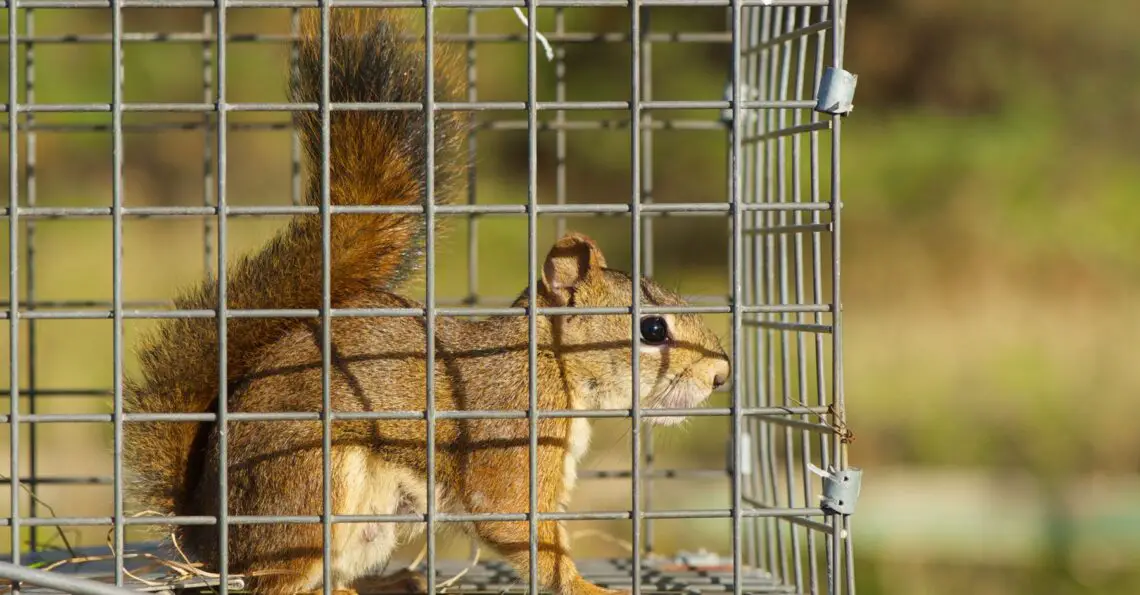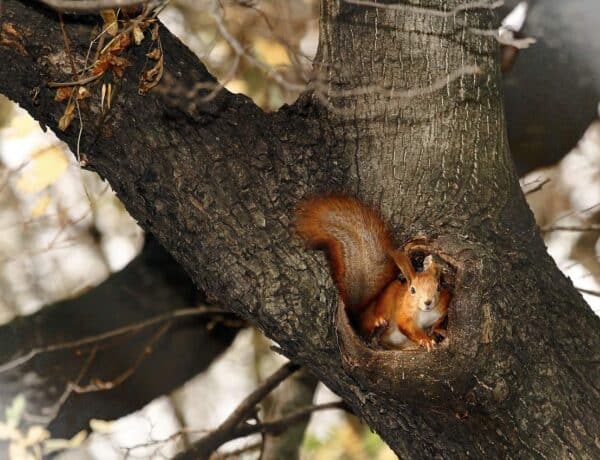Introduction
How To Trap A Squirrel: Squirrels, with their nimble bodies and boundless energy, have long been a source of fascination and sometimes frustration for homeowners and nature enthusiasts alike. These bushy-tailed creatures, often seen darting through trees and scampering across rooftops, bring a touch of wildness to our urban and suburban landscapes. While they can be delightful to watch, they can also become quite the nuisance when they invade our gardens, gnaw on electrical wires, or make a cozy home in our attics. When faced with a squirrel problem, many people wonder how to trap these agile critters safely and effectively. Trapping a squirrel may seem like a straightforward task, but it requires careful consideration, and the right tools to do so humanely and efficiently.
This valuable insights into the art of squirrels herbivores trapping, offering tips, techniques, and considerations to help you successfully manage squirrel-related issues without causing harm to these creatures. Squirrel trapping is not just about capturing these creatures; it’s about striking a balance between coexistence and property protection. Squirrels play a vital role in ecosystems, acting as seed dispersers and contributing to the overall biodiversity of their habitats. Hence, it’s essential to approach trapping with respect for the animal’s well-being and a commitment to relocating them to a suitable environment.
Methods of squirrel trapping, from live traps to exclusion techniques. We’ll delve into the specifics of baiting, trap placement, and safety precautions to ensure a humane and ethical approach to dealing with your squirrel problem. Whether you’re a homeowner looking to protect your garden or a wildlife enthusiast seeking to assist a trapped squirrel, this comprehensive will equip you with the skills needed to handle the situation effectively. So, if you find yourself wondering how to trap a squirrel, you’ve come to the right place.

What is the best bait for a squirrel trap?
Nuts/Peanut Butter
Since just about any unsalted nut will grab a squirrel’s attention, the particular nut is less important than finding a way to keep it in the bait pan. So, if you don’t have peanuts or peanut butter—or you’re allergic to them—consider alternatives such as walnuts or acorns.
Squirrels are famous for their love of acorns. Fresh acorns, particularly those in their natural state, can be a highly effective bait. If you can gather them from oak trees in your area, it may increase your chances of success. Walnuts, both in the shell and shelled, are another favorite squirrel snack. Place a few pieces inside the trap to entice squirrels.
Squirrels are often attracted to sunflower seeds, which are readily available in most garden or pet supply stores. These seeds are a common choice for baiting traps. Pumpkin seeds are another option that squirrels find irresistible. Fresh apple slices can be appealing to squirrels, especially during the fall when apples are abundant.
Squirrels have a sweet tooth, and grapes can be a great bait choice. Cut the grapes in half to make them easier for the squirrel to access. Strawberries and blueberries can also be enticing to squirrels. Spread a thin layer of peanut butter on a piece of bread, cracker, or even a small piece of wood placed inside the trap. Squirrels are drawn to the scent and taste of peanut butter.
Why won’t squirrels go in my trap?
If a squirrel is reluctant to enter your trap, it could be because it is more thirsty than hungry. In that case, it is best to make use of orange slices. These will be a sure way to get the squirrel into the trap, and when you have kept the trap in place for an entire week, the squirrel will have gotten used to it.
Inadequate or unappealing bait can be a major deterrent. Squirrels have specific food preferences, and if your bait choice doesn’t match their tastes, they may ignore your trap. Where you place the bait within the trap matters. Squirrels might avoid going deep into the trap to access the bait. Ensure the bait is positioned at the back of the trap, beyond the trigger plate, to encourage them to enter fully.
Squirrels are clever and agile. If the bait is easily accessible without triggering the trap, they will happily enjoy a free meal and avoid capture. Secure the bait so they must interact with the trigger mechanism. The placement of your trap plays a crucial role. If it’s not positioned in an area frequented by squirrels, they won’t encounter it. Observe their behavior and place traps in areas where you’ve seen them active.
Squirrels are naturally cautious creatures. If they sense any sign of danger, like unusual sounds or vibrations around the trap, they’ll avoid it. Minimize disturbances and make the trap as inconspicuous as possible. Squirrels have a keen sense of smell, and they can detect human scent on traps or bait. Always wear gloves when handling traps and bait to minimize your scent transfer.
Should you trap squirrels?
Trapping is bad for the squirrels
In case you remove them, they will have a hard time trying to find a way to survive. This is not helping them since the change in environment can be lethal to them- their habits will be changed and they may starve to death.
Ethical Considerations: Squirrels are wild animals and have a role in ecosystems as seed dispersers. Trapping and relocating them can raise ethical concerns about disrupting their natural behavior and habitats.
Humane Treatment: Trapping must be done humanely, ensuring that squirrels are not harmed during capture or relocation. Improper trapping methods can cause suffering and stress to the animals.
Reproductive Impact: Removing squirrels from an area can create a vacuum effect, where new squirrels move in to fill the vacant territory. This can lead to a cycle of trapping that may not effectively address the underlying issue.
Legal Considerations: Laws and regulations regarding squirrel trapping vary by location. It’s essential to research and adhere to local and state wildlife regulations before attempting to trap squirrels.
Do squirrels get trap shy?
There is a way to trap cage-shy squirrels, but it’s a process that requires patience. You must first let the animal become acquainted with the new trap, but in a way that doesn’t frighten it. This means that you can’t set it to go off when you first lay it down, instead, leaving it just as a trap, unset, unassuming.
If you suspect trap-shy behavior, try using a different type of trap. Squirrels may not recognize or associate a new trap with previous negative experiences. Avoid placing traps in the same spot repeatedly. Squirrels can learn patterns and may become wary of specific locations. Move traps to different areas where you’ve observed squirrel activity.
Always wear gloves when handling traps, bait, or any items that will come into contact with the bait. Reducing human scent can make the trap less conspicuous to squirrels. Experiment with various bait options to find what works best for your target squirrels. Fresh, enticing bait can sometimes overcome trap-shyness.
Trap-shy squirrels may require more time and persistence. Be patient and persistent in your trapping efforts, and continue to monitor the traps regularly. If you’re having difficulty trapping trap-shy squirrels, consider hiring a professional wildlife removal service. They have experience dealing with these situations and can employ effective, humane trapping methods.
What’s a good squirrel repellent?
Chilli flakes and pepper might put them off, so try a sprinkling of these – it’s often used to keep squirrels off bird feeders. When you come to plant up your borders, consider the scented plants squirrels dislike, such as oniony-smelling members of the allium family, strongly-scented hyacinths and lily of the valley.
Pepper-Based Repellents: Many commercial repellents contain capsaicin, the compound that makes peppers spicy. These sprays or granules can be applied to plants, bird feeders, or other areas you want to protect. The spicy scent and taste can deter squirrels.
Mothballs: Some people use mothballs as a squirrel repellent. However, use them cautiously as they contain toxic chemicals. Place them in a secure container or mesh bag and hang them in the area you want to protect. Be sure to follow safety.
Squirrel-Proofing: To prevent squirrels from accessing specific areas, consider using physical barriers such as wire mesh, netting, or squirrel baffles. These can be effective at keeping squirrels away from bird feeders, gardens, and attics. Installing tree trunk guards or wraps can prevent squirrels from climbing up trees to access bird nests or bird feeders.
Do squirrels sense danger?
Squirrels rely on their senses, especially sight, smell, and hearing, to survive. Thankfully squirrels are gifted with good hearing, seeing and smelling abilities because: They need to be able to detect danger in good time and respond quickly in order to avoid harm.
Squirrels are vigilant animals. They are known for their habit of freezing or standing still when they sense danger. This behavior allows them to blend into their surroundings and avoid detection by predators. Squirrels communicate with each other through a variety of vocalizations, including alarm calls. When they detect danger, they emit loud, distinctive calls to alert other squirrels in the area.
These calls serve as a warning to potential threats and help coordinate group responses to danger. Squirrels are agile and fast runners, and their primary defense mechanism is to flee when they perceive danger. They can quickly navigate trees and branches to escape from ground predators, and they often use a zigzag running pattern to confuse pursuers.
When squirrels sense impending danger or unfavorable weather conditions, they retreat to their nests (dreys) for safety. These nests are often built high in trees, protection from ground-based threats. Squirrels can recognize and specific predators. If they encounter a predator repeatedly, they may become more cautious and vigilant when that predator is nearby.
Are squirrels hard to catch?
Fortunately, it’s easy to catch a squirrel and remove it from your property. You can use a humane “live trap” and release the squirrel back into the wild afterward. If you don’t have a trap around and have a squirrel running around your home, you can also catch it with a blanket.
Squirrels are incredibly agile and quick. They can jump from tree to tree, scale vertical surfaces, and dart through branches with ease. Their agility allows them to escape from predators and traps effortlessly. Squirrels are naturally cautious animals. They approach unfamiliar objects and situations with great care. This caution extends to traps and bait, making them wary of anything that seems out of the ordinary.
Squirrels can learn from their experiences. If they encounter a trap and manage to escape, they may become trap-shy and avoid similar setups in the future. This learning ability can make it challenging to catch squirrels that have had previous encounters with traps. Squirrels often live in groups and communicate with each other. If one squirrel in a group detects danger or a trap, it can alert others, making it more challenging to trap multiple squirrels simultaneously.
Squirrels have a diverse diet and can find food in a variety of places. This means they may not be easily enticed by bait, especially if natural food sources are readily available. Choose a trap designed for squirrels, such as a live-capture trap with a sensitive trigger mechanism. Ensure the trap is in good working condition.
Do squirrels have rabies?
Small rodents (like squirrels, hamsters, guinea pigs, gerbils, chipmunks, rats, and mice) and lagomorphs (including rabbits and hares) are almost never found to be infected with rabies and have not been known to transmit rabies to humans.
Low Incidence in Squirrels: While rabies can theoretically infect any mammal, it is far more common in certain species, such as bats, raccoons, skunks, and foxes. Squirrels are not among the primary reservoirs for the rabies virus, and cases of rabid squirrels are very uncommon.
Behavioral Observations: Squirrels with rabies may display unusual and aggressive behavior, such as staggering, disorientation, and aggression toward humans or other animals. However, such behavior is not typically associated with healthy squirrels.
Rabies Transmission: Rabies is primarily transmitted through the bite or scratch of an infected animal. It is not spread through casual contact, such as touching or being near a rabid animal.
Risk of Transmission: The risk of contracting rabies from a squirrel is extremely low, especially if you avoid handling or approaching wildlife. Squirrels are typically not aggressive toward humans and will flee when approached.

Conclusion
In the realm of wildlife management and pest control, learning how to trap a squirrel responsibly and effectively is a valuable skill. Through the course of this, we’ve explored the intricacies of squirrel trapping, emphasizing humane and ethical approaches to deal with these agile creatures when they become a nuisance. Now, as we conclude this journey, let’s recap the key takeaways and the broader implications of our efforts. First and foremost, it’s crucial that squirrels, with their lively and inquisitive nature, are an integral part of our urban and suburban ecosystems. They contribute to the balance of these environments by dispersing seeds and supporting biodiversity.
Therefore, when confronted with a squirrel issue, it’s essential to approach it with respect for the animals and a commitment to their well-being. Live trapping has emerged as one of the most humane methods to capture and relocate squirrels. These traps allow for the safe removal of squirrels from areas where they pose a threat to property or safety. However, using live traps also comes with responsibilities. It’s vital to check the traps regularly and release the captured squirrels into suitable environments where they can thrive without causing harm or squirrels inconvenient. Throughout this we’ve discussed the of selecting the right bait, proper trap placement, and safety precautions.
These elements play a significant role in the success of your trapping efforts. By choosing appropriate bait and positioning traps strategically, you increase your chances of capturing the target squirrel while minimizing the risk of unintentionally trapping other animals. By sealing entry points and securing your property against squirrel intrusion, you can avoid future issues and maintain a harmonious coexistence with these creatures. In learning how to trap a squirrel is not just about pest control; it’s about responsible stewardship of the natural world within our midst. By approaching squirrel trapping with empathy, respect for wildlife, and a commitment to ethical practices, we can strike a balance between protecting our property and preserving the beauty and diversity of our environment.





No Comments